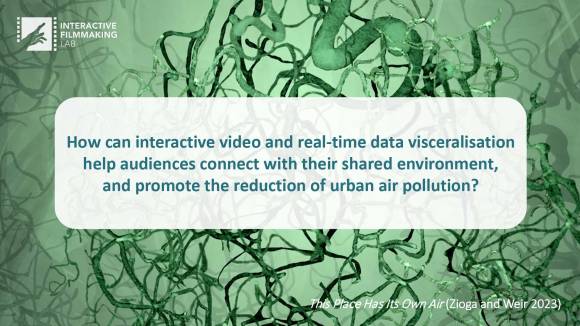“Enheduanna—A Manifesto of Falling” Live Brain-Computer Cinema Performance: Performer and Audience Participation, Cognition and Emotional Engagement Using Multi-Brain BCI Interaction
Polina Zioga1*, Frank Pollick2, Minhua Ma1, Paul Chapman3 and Kristian Stefanov1,2
1Interactive Filmmaking Lab, School of Computing and Digital Technologies, Staffordshire University, Stoke-on-Trent, United Kingdom
2Perception Action Cognition Lab, School of Psychology, University of Glasgow, Glasgow, United Kingdom
3School of Simulation and Visualisation, Glasgow School of Art, Glasgow, United Kingdom
Abstract: The fields of neural prosthetic technologies and Brain-Computer Interfaces (BCIs) have witnessed in the past 15 years an unprecedented development, bringing together theories and methods from different scientific fields, digital media, and the arts. More in particular, artists have been amongst the pioneers of the design of relevant applications since their emergence in the 1960s, pushing the boundaries of applications in real-life contexts. With the new research, advancements, and since 2007, the new low-cost commercial-grade wireless devices, there is a new increasing number of computer games, interactive installations, and performances that involve the use of these interfaces, combining scientific, and creative methodologies. The vast majority of these works use the brain-activity of a single participant. However, earlier, as well as recent examples, involve the simultaneous interaction of more than one participants or performers with the use of Electroencephalography (EEG)-based multi-brain BCIs. In this frame, we discuss and evaluate “Enheduanna—A Manifesto of Falling,” a live brain-computer cinema performance that enables for the first time the simultaneous real-time multi-brain interaction of more than two participants, including a performer and members of the audience, using a passive EEG-based BCI system in the context of a mixed-media performance. The performance was realised as a neuroscientific study conducted in a real-life setting. The raw EEG data of seven participants, one performer and two different members of the audience for each performance, were simultaneously recorded during three live events. The results reveal that the majority of the participants were able to successfully identify whether their brain-activity was interacting with the live video projections or not. A correlation has been found between their answers to the questionnaires, the elements of the performance that they identified as most special, and the audience’s indicators of attention and emotional engagement. Also, the results obtained from the performer’s data analysis are consistent with the recall of working memory representations and the increase of cognitive load. Thus, these results prove the efficiency of the interaction design, as well as the importance of the directing strategy, dramaturgy and narrative structure on the audience’s perception, cognitive state, and engagement.
Keywords: live brain-computer cinema performance, brain-computer interface (BCI), multi-brain interaction, electroencephalography (EEG), performer, audience participation, attention, emotional engagement
Complete article available on: frontiersin.org/articles/10.3389/fnins.2018.00191
Citation: Zioga P, Pollick F, Ma M, Chapman P and Stefanov K (2018) “Enheduanna—A Manifesto of Falling” Live Brain-Computer Cinema Performance: Performer and Audience Participation, Cognition and Emotional Engagement Using Multi-Brain BCI Interaction. Front. Neurosci. 12:191. doi: 10.3389/fnins.2018.00191
Received: 18 October 2017; Accepted: 09 March 2018; Published: 03 April 2018.
Edited by: Fivos Panetsos, Complutense University of Madrid, Spain
Reviewed by: Jing Jin, East China University of Science and Technology, China; Celia Herrera-Rincon, Tufts University, United States
Copyright © 2018 Zioga, Pollick, Ma, Chapman and Stefanov. This is an open-access article distributed under the terms of the Creative Commons Attribution License (CC BY). The use, distribution or reproduction in other forums is permitted, provided the original author(s) and the copyright owner are credited and that the original publication in this journal is cited, in accordance with accepted academic practice. No use, distribution or reproduction is permitted which does not comply with these terms.





